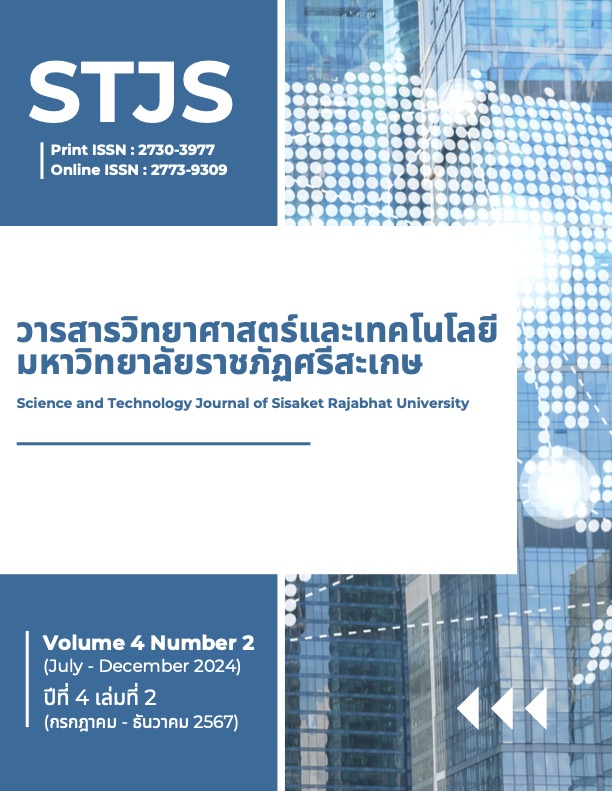การเปรียบเทียบผลสัมฤทธิ์การสร้างหุ่นจำลองโครงสร้างอาคาร ด้วยแบบก่อสร้างและแบบจำลองสารสนเทศอาคาร (BIM)
Main Article Content
บทคัดย่อ
การวิจัยครั้งนี้มีวัตถุประสงค์เพื่อศึกษาและเปรียบเทียบผลสัมฤทธิ์การเรียนรู้ในการสร้างหุ่นจำลองโครงสร้างอาคารชั้นเดียว โดยใช้แบบก่อสร้างสองมิติ (2D) และแบบจำลองสารสนเทศอาคาร (Building Information Modeling, BIM) การวิจัยแบ่งนักศึกษาออกเป็นสองกลุ่ม ได้แก่ กลุ่ม A ที่ใช้แบบก่อสร้างสองมิติในการสร้างหุ่นจำลอง และกลุ่ม B ที่ใช้แบบจำลองสารสนเทศอาคาร (BIM) ในการสร้างหุ่นจำลอง เพื่อวัดประสิทธิ ภาพการใช้เวลา ความถูกต้อง และความเข้าใจในองค์ประกอบโครงสร้างอาคารก่อนและหลังการสร้างหุ่นจำลอง ผลการวิจัยพบว่า กลุ่ม B ใช้เวลาในการสร้างหุ่นจำลองน้อยกว่ากลุ่ม A ในทุกองค์ประกอบของการสร้างหุ่นจำลอง ค่า SD ของกลุ่ม B ต่ำกว่ากลุ่ม A แสดงถึงความสม่ำเสมอและประสิทธิภาพที่ดีกว่า นอกจากนี้ กลุ่ม B ยังมีประสิทธิภาพในการสร้างองค์ประกอบโครงสร้างฐานราก เสา และคานดีกว่ากลุ่ม A อย่างมีนัยสำคัญทางสถิติ (p-value < 0.05) ในแง่ของความถูกต้อง คะแนนเฉลี่ยของกลุ่ม B สูงกว่ากลุ่ม A ในองค์ประกอบฐานรากและหลังคา แม้ว่าผลการทดสอบ t-test จะไม่แสดงความแตกต่างอย่างมีนัยสำคัญทางสถิติ (p-value > 0.05) แต่กลุ่ม B มีค่า SD ต่ำกว่ากลุ่ม A ในทุกองค์ประกอบ ซึ่งแสดงถึงความสม่ำเสมอและความแม่นยำที่ดีกว่า ผลการวิจัยยังชี้ให้เห็นว่า คะแนนความเข้าใจองค์ประกอบโครงสร้างอาคารของกลุ่ม B ดีกว่ากลุ่ม A ทั้งก่อนและหลังการสร้างหุ่นจำลอง โดยกลุ่ม B มีคะแนนเฉลี่ยเพิ่มขึ้นมากกว่ากลุ่ม A หลังการสร้างหุ่นจำลอง ซึ่งสอดคล้องกับงานวิจัยก่อนหน้านี้ที่ระบุว่า การใช้ BIM ช่วยเสริมสร้างความเข้าใจในองค์ประกอบโครงสร้างอาคารได้ดีขึ้น จากผลการวิจัยนี้สามารถสรุปได้ว่า การใช้เทคโนโลยี BIM ไม่เพียงเพิ่มประสิทธิภาพในการสร้างหุ่นจำลองโครงสร้าง แต่ยังช่วยประหยัดเวลาในการทำงานและเพิ่มความเข้าใจของนักศึกษาในองค์ประกอบโครงสร้างอาคารได้ดีกว่าวิธีการแบบก่อสร้างสองมิติ การนำ BIM มาใช้ในการเรียนการสอนจึงเป็นแนวทางที่มีประสิทธิภาพในการพัฒนาทักษะและความรู้ของนักศึกษาในสาขาวิชาช่างโยธา
Article Details

อนุญาตภายใต้เงื่อนไข Creative Commons Attribution-NonCommercial-NoDerivatives 4.0 International License.
เนื้อหาและข้อมูลในบทความที่ลงตีพิมพ์ในวารสารวิทยาศาสตร์และเทคโนโลยี มหาวิทยาลัยราชภัฏศรีสะเกษ ถือเป็นข้อคิดเห็นและความรับผิดชอบของผู้เขียนบทความโดยตรงซึ่งกองบรรณาธิการวารสาร ไม่จำเป็นต้องเห็นด้วย หรือร่วมรับผิดชอบใด ๆ
บทความ ข้อมูล เนื้อหา รูปภาพ ฯลฯ ที่ได้รับการตีพิมพ์ในวารสารวิทยาศาสตร์และเทคโนโลยี มหาวิทยาลัยราชภัฏศรีสะเกษ ถือเป็นลิขสิทธิ์ของวิทยาศาสตร์และเทคโนโลยี มหาวิทยาลัยราชภัฏศรีสะเกษ หากบุคคลหรือหน่วยงานใดต้องการนำทั้งหมดหรือส่วนหนึ่งส่วนใดไปเผยแพร่ต่อหรือเพื่อกระทำการใด จะต้องได้รับอนุญาตเป็นลายลักอักษรจากวารสารวิทยาศาสตร์และเทคโนโลยี มหาวิทยาลัยราชภัฏศรีสะเกษ ก่อนเท่านั้น
เอกสารอ้างอิง
Azhar, S. (2011). Building Information Modeling (BIM): Trends, Benefits, Risks, and
Challenges for the AEC Industry. Leadership and Management in Engineering,
(3), 241-252. [Online]. Retrieved July 8, 2024, from: https://ascelibrary.org/
doi.
Barison, M. B., & Santos, E. T. (2010). BIM teaching strategies: An overview of the
current approaches. Proceedings of the International Conference on
Computing in Civil and Building Engineering, Nottingham, UK. [Online].
Retrieved July 8, 2024, from: https://www.researchgate.net/publication.
Eastman, C., Teicholz, P., Sacks, R., & Liston, K. (2011). BIM handbook: A guide to
building information modeling for owners, managers, designers, engineers and
contractors. John Wiley & Sons. [Online]. Retrieved July 8, 2024, from:
https://www.researchgate.net/publication.
Ibrahim, R., & Rahimian, F. P. (2010). Comparison of CAD and manual sketching tools
for teaching architectural design. Automation in Construction, 19(8), 978-987.
[Online]. Retrieved July 10, 2024, from: https://www.academia.edu/260827.
Jitsa-ngiam, J., Wongthong, S., & Saenkham, W. (2023). Application of BIM
technology in teaching civil engineering drawing. Journal of Engineering, 15(2), 45-60. (In Thai)
Johnson, M. (2023). Enhancing student learning outcomes through BIM technology.
International Journal of Engineering Education, 29(2), 123-134. [Online]. Retrieved July 10, 2024, from: https://www.tandfonline.com/doi.
Jones, R. (2023). The impact of structural models on student learning in civil
engineering. Education in Engineering and Technology, 15(1), 98-110. [Online].
Retrieved July 11, 2024, from: https://www.researchgate.net/publication.
Ministry of Education. (2019). Curriculum for Vocational Certificate, B.E. 2562. Bangkok:
Office of the Basic Education Commission. (In Thai)
Sacks, R., Eastman, C. M., Lee, G., & Teicholz, P. (2010). BIM for building design and
construction. [Online]. Retrieved July 11, 2024, from:
Smith, K. (2022). Building Information Modeling (BIM) as a teaching tool in
construction education. Journal of Building Technology, 16(3), 345-359. [Online]. Retrieved July 11, 2024, from: https://www.tandfonline.com/doi.
The Engineering Institute of Thailand under H.M. The King's Patronage. (2014).
Standards for the design and construction of reinforced concrete buildings.
(In Thai)
Thompson, E. (2020). Applying behaviorism and constructivism in vocational
education. Journal of Vocational Education Research, 22(1), 34-50. [Online]. Retrieved July 10, 2024, from: https://scholar.google.co.th


